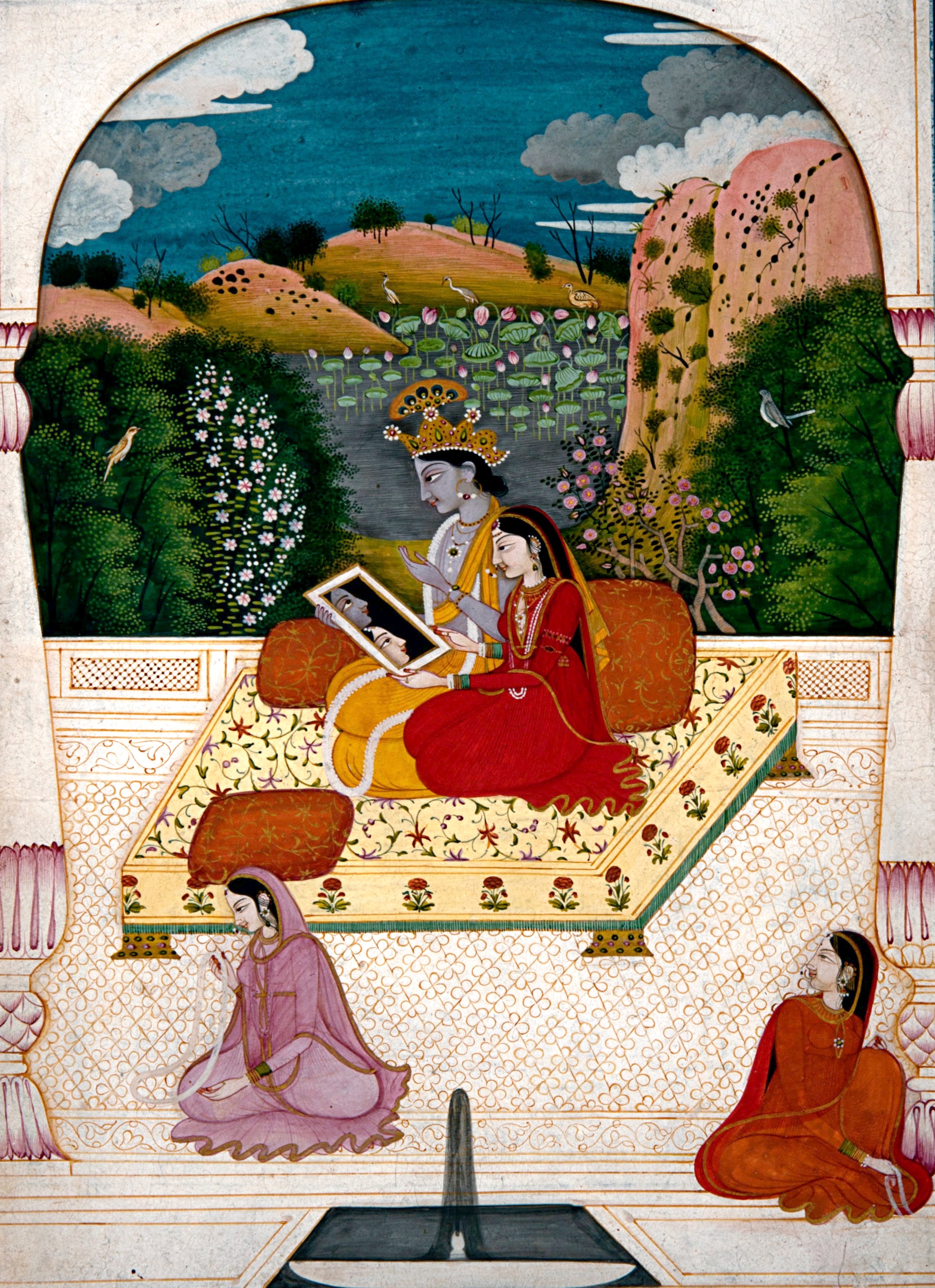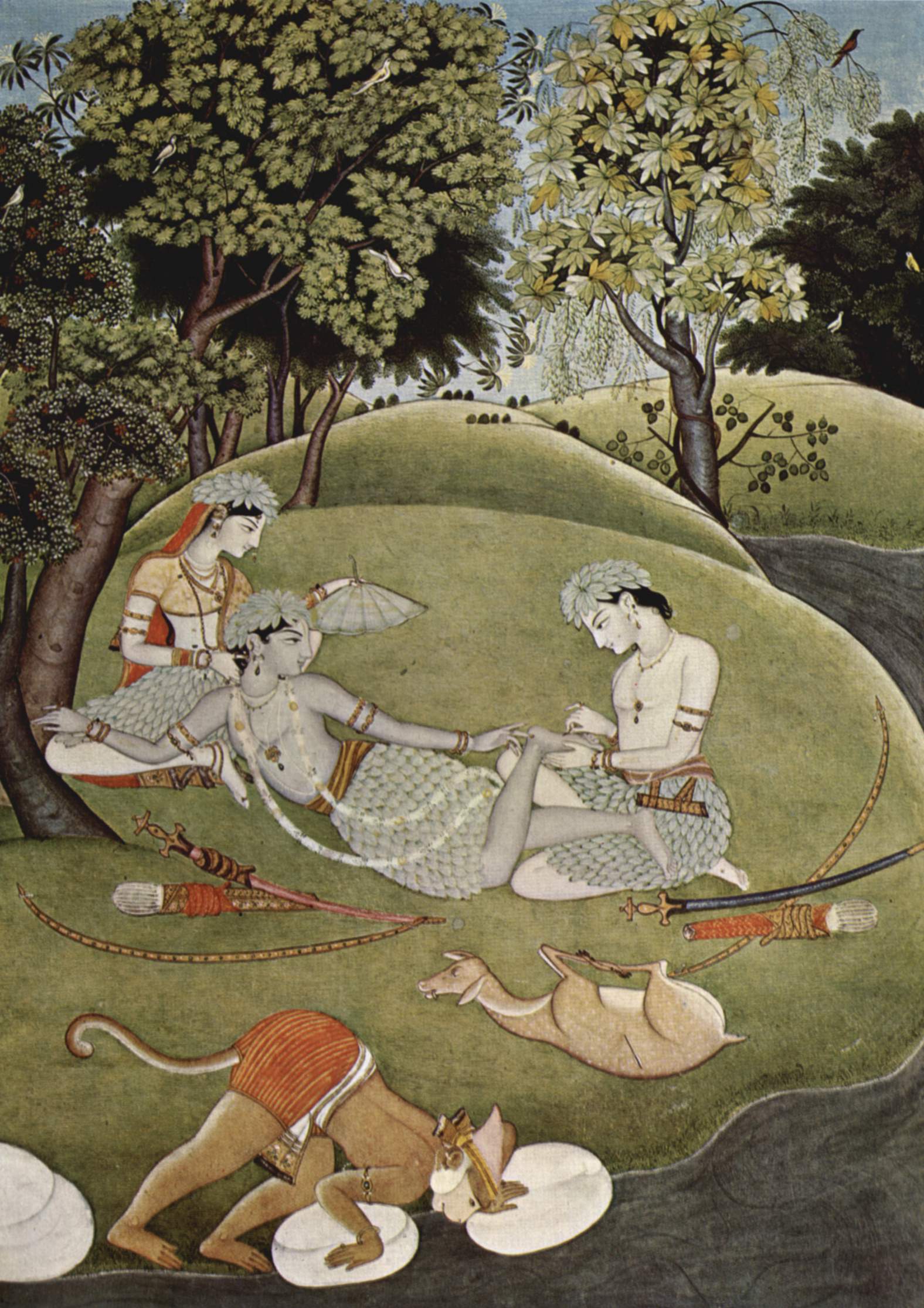|
Purkhu Of Kangra
Purkhu (fl. 1780–1820), also spelt as Purkhoo or Parkhu, and also known as Purkhu of Kangra, was a Pahari painter who specialized in the Kangra-style. He painted both courtly and religious themes. Biography and works Purkhu was the son of Dhummun. Purkhu was likely the head ''chitrera'' (artist) of a courtly atelier based out of Kangra State during the reign of Sansar Chand (r. 1775–1823). In his works, he documented both the public and private lives of his patron. Purkhu also produced a series of religious art works based upon the '' Harivamsa'', ''Shiva Purana'', ''Ramayana'', ''Gita Govinda'', and ''Kedara Kalpa''. Purkhu's disciple was Basharat Ullah. Style When comparing the works of earlier Pahari artists belonging to the first generation after Nainsukh Nainsukh (; 1710 – 1778) was an Indian painter. He was the younger son of the painter Pandit Seu and, like his older brother Manaku of Guler, was an important practitioner of Pahari painting, and ... [...More Info...] [...Related Items...] OR: [Wikipedia] [Google] [Baidu] |
Pahari Painting
Pahari painting () is an umbrella term used for a form of Indian painting, done mostly in miniature forms, originating from the lower Himalayan hill kingdoms of North India, during the early 17th to mid 19th century, notably Basohli, Mankot, Nurpur, Chamba, Kangra, Guler, Mandi and Garhwal. Nainsukh was a famous master of the mid-18th century, followed by his family workshop for another two generations. The central theme of Pahari painting is depiction of eternal love of the Hindu deities Radha and Krishna. A distinct lyricism, spontaneous rhythm, softness, minute intricate details of composition, and intense perception and portrayal of human emotions and physical features distinguish the Pahari miniatures from the other miniature schools like Deccan, Mughal and Rajasthani-Rajput. Origin and area The Pahari school developed and flourished during the 17th and 19th centuries, stretching from Jammu to Garhwal, in the sub- Himalayan India, through Himachal Pradesh. Each cr ... [...More Info...] [...Related Items...] OR: [Wikipedia] [Google] [Baidu] |
Kangra Painting
Kangra painting (Hindi: कांगड़ा चित्रकारी) is the Visual arts, pictorial art of Kangra, Himachal Pradesh, Kangra, named after the Kangra State, a former princely state of Himachal Pradesh, which patronized the art. The art style became prevalent with the fading of the Basohli Painting, Basohli school of painting in the mid-18th century. Later, Kangra paintings were produced in such magnitude, both in content and volume, that the Pahari painting school came to be known as the Kangra painting school. Kangra painting style was registered under the Geographical Indications of Goods (Registration and Protection) Act, 1999, Geographical Indication of Goods (Registration and Protection) Act, 1999 on 2 April 2012. Historically, the main centres of Kangra paintings have been Guler State, Guler, Basohli, Chamba State, Chamba, Nurpur State, Nurpur, Bilaspur State, Bilaspur and Kangra. Later, this style also reached Mandi State, Mandi, Suket State, Suket, Kull ... [...More Info...] [...Related Items...] OR: [Wikipedia] [Google] [Baidu] |
Sikh Art
Sikh art, also known as the Sikh School, is the artwork created by or associated with Sikhs and Sikhism. Sikh artwork exists in many forms, such as miniature, oil, and watercolour paintings, murals, and wood carvings. The first Sikh artists were influenced by the Pahari and Mughal schools, however the ushering in of European influences during the colonial-age would transform Sikh art by adopting Western methods and tastes for artwork. Terminology and categories In 19th century Punjab, there were two main types of artists: musawirs and naqqashas. They worked independently of one another and focued on different spheres, with their styles, materials, and techniques differing from one another. Musawirs The ''Musawirs'' were painters who drew animated objects. Some artists who specialized in this field were Kishan Singh and Chajju, Imam Bakhsh, and Mohammad Bakhsh. The musawir artists relied on their own memory to reproduce an artistic depiction of someone. One method they used ... [...More Info...] [...Related Items...] OR: [Wikipedia] [Google] [Baidu] |
Floruit
''Floruit'' ( ; usually abbreviated fl. or occasionally flor.; from Latin for 'flourished') denotes a date or period during which a person was known to have been alive or active. In English, the unabbreviated word may also be used as a noun indicating the time when someone flourished. Etymology and use is the third-person singular perfect active indicative of the Latin verb ', ' "to bloom, flower, or flourish", from the noun ', ', "flower". Broadly, the term is employed in reference to the peak of activity for a person or movement. More specifically, it often is used in genealogy and historical writing when a person's birth or death dates are unknown, but some other evidence exists that indicates when they were alive. For example, if there are Will (law), wills Attestation clause, attested by John Jones in 1204 and 1229, as well as a record of his marriage in 1197, a record concerning him might be written as "John Jones (fl. 1197–1229)", even though Jones was born before ... [...More Info...] [...Related Items...] OR: [Wikipedia] [Google] [Baidu] |
Atelier
An atelier () is the private workshop or studio of a professional artist in the fine or decorative arts or an architect, where a principal master and a number of assistants, students, and apprentices can work together producing fine art or visual art released under the master's name or supervision. Ateliers were the standard vocational practice for European artists from the Middle Ages to the 19th century, and common elsewhere in the world. In medieval Europe this way of working and teaching was often enforced by local guild regulations, such as those of the painters' Guild of Saint Luke, and of other craft guilds. Apprentices usually began working on simple tasks when young, and after some years with increasing knowledge and expertise became journeymen, before possibly becoming masters themselves. This master-apprentice system was gradually replaced as the once powerful guilds declined, and the academy became a favored method of training. However, many professional artists ... [...More Info...] [...Related Items...] OR: [Wikipedia] [Google] [Baidu] |
Kangra State
Kangra-Lambagraon was a historical state and later princely estate (''jagir'') of British India located in the present-day state of Himachal Pradesh. The rulers of the estate belonged to the ancient Katoch dynasty which had ruled the former Kangra State. Kangra is credited with being the oldest and largest state in the Western Himalayan Region. In 1846 Kangra was annexed to British India as part of the Treaty of Lahore. History Early history of the Kangra State The first modern recorded mention of the state, however, is from the 11th century AD. The Katoch dynasty are reputed to have ruled the town of Kangra and its vicinity since time immemorial. Several very extended interregnums are acknowledged. Medieval invasions At least three rulers sought to conquer the Kangra fort and plundered the treasures of its temples: Mahmud Ghazni in 1009, Firuz Shah Tughluq in 1360 and Sher Shah in 1540. During Prithvi Chand II's reign in 1333, he defeated the army of Muhammad b ... [...More Info...] [...Related Items...] OR: [Wikipedia] [Google] [Baidu] |
Sansar Chand
Sansar Chand (c. 1765 – 1824) was a Punjabi Rajput ruler of the erstwhile Kangra State in what is now the Indian state of Himachal Pradesh. Early life Sansar Chand was a scion of the Katoch dynasty, which ruled Kangra for centuries until they were ousted by the Mughals in the early 17th century. In 1758, Sansar Chand's grandfather, Ghamand Chand, was appointed governor of Jalandhar by Ahmed Shah Abdali. Sansar Chand rallied an army, ousted the Mughal governor of Kangra, Saifu Ali Khan Kaymkhani, and regained possession of his patrimony. Sansar Chand did a lot of work for the welfare of people mainly residing in nearby places apart from Kangra like Palampur, Hamirpur. He built many water distributaries. The water was used for farming and livestock. Military career Conflict with hilly states In the historic Battle of Rehlu (1794), the Chamba chief, in collaboration with the Raja of Nurpur, confronted the formidable forces of Sansar Chand, supported by the chief of Gul ... [...More Info...] [...Related Items...] OR: [Wikipedia] [Google] [Baidu] |
Harivaṃśa
The ''Harivamsa'' (, ) is an important work of Sanskrit literature, containing 16,374 shlokas, mostly in the ''anustubh'' Metre (poetry), metre. The text is also known as the ''Harivamsa Purana.'' This text is believed to be a ''khila'' (appendix or supplement) to the ''Mahabharata''The Mahabharata in Sanskrit: Book I: Chapter 2 in sacred-texts.com website, (MBh.1.2.69): "hari vaṃśas tataḥ parva purāṇaṃ khila saṃjñitam bhaviṣyat parva cāpy uktaṃ khileṣv evādbhutaṃ mahat." ["Hari Vamsa Purana known as Khila (supplement) and Bhavishya Parva also spoken as Khila are wonderful and great"]. and is traditionally ascribed to Veda Vyasa, Vyasa. The most celebrated commentary of the ''Mahabharata'' by Neelakantha Chaturdhara, the ''Bharata Bhava Deepa'' also covers the ''Harivam ... [...More Info...] [...Related Items...] OR: [Wikipedia] [Google] [Baidu] |
Shiva Purana
The ''Shiva Purana'' (original Sanskrit title: Śivapurāṇa (शिवपुराण) and Śivamahāpurāṇa (शिवमहापुराण) is one of eighteen major texts of the '' Purana'' genre of Sanskrit texts in Hinduism, and part of the Shaivism literature corpus. It primarily revolves around the Hindu god Shiva and goddess Parvati, but references and reveres all gods. The ''Shiva Purana'' asserts that it once consisted of 100,000 verses set out in twelve Samhitas (Books); however, the Purana adds that it was abridged by Sage Vyasa before being taught to Romaharshana. The surviving manuscripts exist in many different versions and content, with one major version with seven books (traced to South India), another with six books, while the third version traced to the medieval Bengal region of the Indian subcontinent with no books but two large sections called ''Purva-Khanda'' (Previous Section) and ''Uttara-Khanda'' (Later Section). The two versions that include books, ... [...More Info...] [...Related Items...] OR: [Wikipedia] [Google] [Baidu] |
Ramayana
The ''Ramayana'' (; ), also known as ''Valmiki Ramayana'', as traditionally attributed to Valmiki, is a smriti text (also described as a Sanskrit literature, Sanskrit Indian epic poetry, epic) from ancient India, one of the two important epics of Hinduism known as the ''Itihasas'', the other being the ''Mahabharata''. The epic narrates the life of Rama, the seventh ''avatar'' of the Hindu deity Vishnu, who is a prince of Ayodhya (Ramayana), Ayodhya in the kingdom of Kosala. The epic follows Exile of Lord Rama, his fourteen-year exile to the forest urged by his father King Dasharatha, on the request of Rama's stepmother Kaikeyi; his travels across the forests in the Indian subcontinent with his wife Sita and brother Lakshmana; the kidnapping of Sita by Ravana, the king of Lanka, that resulted in bloodbath; and Rama's eventual return to Ayodhya (Ramayana), Ayodhya along with Sita to be crowned as a king amidst jubilation and celebration. Scholarly estimates for the earliest stage ... [...More Info...] [...Related Items...] OR: [Wikipedia] [Google] [Baidu] |
Gita Govinda
The ''Gita Govinda'' (; IAST: ''gītagovindam'') is a work composed by the 12th-century Hindu poet, Jayadeva. It describes the relationship between Krishna, Radha and ''gopis'' (female cow herders) of Vrindavan. The ''Gita Govinda'' is organized into twelve chapters. Each chapter is further sub-divided into one or more divisions called p''rabandha''s, totalling twenty-four in all. The prabandhas contain couplets grouped into eights, called '' ashtapadis''. The text also elaborates the eight moods of Heroine, the '' Ashta Nayika'', which has been an inspiration for many compositions and choreographic works in Indian classical dances. Every night in the Jagannatha temple, the ''Gitagovinda'' of Jayadeva is sung in the style of Odissi music, a tradition that has continued unbroken since the time of Jayadeva himself. Musicians of Kerala have adapted the ''ashtapadis'' into a musical form performed in temples called ''sopana sangeetham.'' Jayadeva's hymns are also included in the Gu ... [...More Info...] [...Related Items...] OR: [Wikipedia] [Google] [Baidu] |







